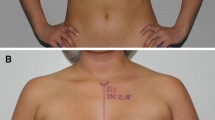Abstract
Introduction
When planning for breast augmentation, it is important to consider not only implant choice, surgical technique and patient desires, but also the chest wall shape and deformities or irregularities, which remain often underestimated. They can be responsible for implant malposition and breast asymmetry after augmentation. Chondrocostal junction prominence is a minor but frequent chest wall deformity. The aim of this study is to report a new technique for sculpturing isolated chondrocostal prominence deformities in patients undergoing breast augmentation.
Methods
A retrospective study was conducted to review surgical outcomes of a novel technique for costal prominence sculpturing and reshaping in patients undergoing breast augmentation.
After reaching the subpectoral space, an inferiorly-based perichondral–periosteal flap is harvested just above the prominence. Once the deformity is corrected, the perichondral flap is repositioned over the sculpted rib.
Results
A total of six patients presenting with isolated chondrocostal prominence underwent bilateral breast implant placement and costal reduction using the described technique. Three patients were primary augmentations while the remaining patients were two secondary breast augmentation and one augmentation mastopexy. No complications were reported. No additional pain was referred at the side of rib remodelling in comparison with the contralateral breast. All the patients were satisfied with cosmetic results.
Conclusions
The described technique for contouring of isolated chondrocostal deformities is fast, easy reproducible and offers advantages over the standard partial rib reduction technique. It can prevent implant malposition and projection asymmetry, eventually enhancing breast augmentation outcomes.
Level of Evidence V
This journal requires that authors assign a level of evidence to each article. For a full description of these Evidence-Based Medicine ratings, please refer to the Table of Contents or the online Instructions to Authors www.springer.com/00266.


Similar content being viewed by others
References
Hodgkinson DJ (2002) The management of anterior chest wall deformity in patients presenting for breast augmentation. Plast Reconstr Surg 109(5):1714–1723. https://doi.org/10.1097/00006534-200204150-00039
Ors S (2017) Incidence and classification of chest wall deformities in breast augmentation patients. Aesthetic Plast Surg 41(6):1280–1290. https://doi.org/10.1007/s00266-017-0953-5
Andrades P, Quispe D, Dominguez C et al (2019) Winged ribs: an underestimated problem that may compromise breast augmentation outcomes. Aesthetic Plast Surg 43(4):899–904. https://doi.org/10.1007/s00266-019-01385-7
Bayram Y, Zor F, Karagoz H, Kulahci Y, Afifi AM, Ozturk S (2016) Challenging breast augmentations: the influence of preoperative anatomical features on the final result. Aesthet Surg J 36(3):313–320. https://doi.org/10.1093/asj/sjv181
Ioppolo L, Alessandri Bonetti M, De Lorenzi F (2023) Tuberous breasts associated with chest wall deformity: a challenging planning for breast augmentation, Aesthetic Plast Surg. https://doi.org/10.1007/s00266-023-03784-3
Scott J, Huskisson EC (1976) Graphic representation of pain. Pain 2(2):175–184
Spear SL, Romm S, Hakki A, Little JW (1987) Costal cartilage sculpturing as an adjunct to augmentation mammaplasty. Plast Reconstr Surg 79(6):921–926
Funding
The authors have nothing to disclose.
Author information
Authors and Affiliations
Corresponding author
Ethics declarations
Conflict of interest
The authors declare that they have no conflicts of interest to disclose.
Ethical Approval
This study followed the Declaration of Helsinki on medical protocols and ethics, and the ethical review board of our institution approved the study.
Informed Consent
Each patient signed a written informed consent document.
Additional information
Publisher's Note
Springer Nature remains neutral with regard to jurisdictional claims in published maps and institutional affiliations.
Supplementary Information
Below is the link to the electronic supplementary material.
Video 1: The isolated chondrocostal prominence can cause breast implant lateralization leading to breast asymmetry. (AVI 13763 KB)
Video 2: Intraoperative video showing the developed technique for contouring and reduction of the chondrocostal prominence. (MP4 199676 KB)
Rights and permissions
Springer Nature or its licensor (e.g. a society or other partner) holds exclusive rights to this article under a publishing agreement with the author(s) or other rightsholder(s); author self-archiving of the accepted manuscript version of this article is solely governed by the terms of such publishing agreement and applicable law.
About this article
Cite this article
Ioppolo, L., Borelli, F., Alessandri Bonetti, M. et al. Rib Reduction Technique in Patients with Isolated Chondrocostal Chest Wall Prominence Undergoing Breast Augmentation. Aesth Plast Surg (2024). https://doi.org/10.1007/s00266-024-04006-0
Received:
Accepted:
Published:
DOI: https://doi.org/10.1007/s00266-024-04006-0




